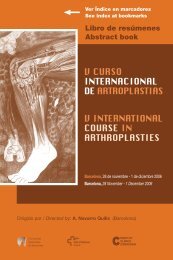Notas / Notes - Active Congress.......
Notas / Notes - Active Congress.......
Notas / Notes - Active Congress.......
Create successful ePaper yourself
Turn your PDF publications into a flip-book with our unique Google optimized e-Paper software.
MARTES / TUESDAY<br />
34<br />
mm steps and evaluated in comparison with the postoperative<br />
radiographs to see whether they had become smaller spontaneously<br />
or had been obliterated.<br />
RESULTS<br />
Two patients of the overall group (376 hips) were reoperated:<br />
one because of an early infection and one because of cup<br />
breakage. No polyethylene liner was exchanged because of<br />
wear or inestability. The radiographic analysis showed tilting<br />
into the valgus-position in 2 patients, into the varus-position<br />
in 1. These 3 cup shells were radiographically loose at the<br />
follow-up. The surrounding bone stock showed progressive<br />
osseointegration in 134 implants, in 91 cups the bone reaction<br />
was indifferent, 2 cups showed integration and some atrophy,<br />
1 cup stable fibrous ingrowth. In 1 case a severe osteolysis<br />
was found. In this case after the end of the study an exchange<br />
of the PE-liner as well as of the ball head was done. The<br />
cup was stable and left in place. The Kaplan-Meier survival<br />
rate with revision for any reason was 99.3% (95%, CI: 96.9%<br />
– 99.8%) after 10 years. The survival rate with revision for<br />
any reason and radiologic loosening was 98.6% (95%, CI:<br />
96.0% - 99.5%) at 10 years. Triangular cranial gaps were<br />
present postoperatively in 50 hips (21.5%). The gaps tended<br />
to spontaneously fill by newly formed bone. Thirty-six of<br />
these gaps (72%) were completely obliterated at the 10-year<br />
followup. Gaps between the metal shell and the acetabular<br />
floor were present in 47 hips (20.3%) postoperatively. In<br />
thirty-seven of these hips (78.7%), the gaps measured 0 to<br />
2 mm. Nine patients had gaps of as much as 4 mm and one<br />
of as much as 6 mm. These gaps also tended to be spontaneously<br />
obliterated. The two valgus migrations were<br />
associated with newly formed gaps in Position 2.<br />
CONCLUSION<br />
Implant survivorship was comparable to the best published<br />
10-year survival rates with the Harris-Galante and other<br />
types of hemispheric cups, however with an encouragingly<br />
low rate of complications related to the PE liner observed in<br />
our series.. The exclusive use of this implant in all indications<br />
for primary hip replacement demonstrated that the results<br />
of the Bicon Cup will be beneficial in almost all cases including<br />
difficult hips.In the next decade it needs to be determined<br />
whether the fixation method of the metal cup shell in the<br />
pelvis and the stability of the PE-liner in the metal-PE-interface<br />
of the study device will lead to lower occurrence of osteolysis<br />
and an improved longevity.<br />
CEMENTLESS CUP: LESSONS FROM<br />
RETRIEVAL STUDIES<br />
Jorge O. Galante, Robert Urban<br />
Rush Arthritis & Orthopaedic Institute<br />
St. Luke’s Medical Center,<br />
Illinois (USA)<br />
Histopathological findings were reviewed on retrieved autopsy<br />
specimens for the purpose of identifying the causes of long<br />
term failure.<br />
The study group consisted of twenty four primary porouscoated<br />
Ti acetabular cups (HG1 or HG II) retrieved at autopsy<br />
5 to 21 years after implantation.<br />
All specimens exhibited bone ingrowth with more bone present<br />
at the components rim and in the vicinity of screws. The<br />
extent was 35% (7 to 70%).<br />
Particles within granulomas were present within holes and<br />
in the rim in all components.<br />
Expansion of granulomas through the screw holes into the<br />
periprosthetic bone was obvious in the longer term specimens.<br />
Granuloma penetration was deeper along screw tracts extending<br />
often through the whole length of the screw. Screw<br />
holes with or without screws were the main pathway for extension<br />
of granulomas into the retroacetabular bone.<br />
Pelvic granulomas increased from a few millimeters at 5 to10<br />
years to ballooning massive lesions at longer follow up, most<br />
often not visualized on plain radiographs. In all of the long<br />
term cases there was invasion of the interface and of the<br />
porous coating itself.<br />
The mean volumetric wear rate was 47 mm3/yr. Damage to<br />
the back side of the liner was moderate.<br />
The mechanism responsible for long term failure is related<br />
to wear and granuloma formation.<br />
These phenomena can lead to massive pelvic osteolysis and<br />
or eventual loosening by invasion of the porous coating by<br />
granuloma as the actual causes of failure.





